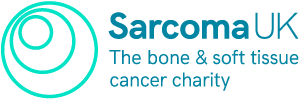This page is all about chordoma. It includes advice on the symptoms of chordoma, as well as how chordoma is treated.
Chordoma is a rare type of bone sarcoma that can happen anywhere along the spine.
Chordoma is pronounced ‘core-dome-ah’.
What is chordoma?
Around 54 people are diagnosed with chordoma each year. Chordoma most commonly affects people aged 50 to 70.
Half of all chordomas are found in the sacrum (the bottom of the spine). 30% are found at the base of the skull, and the remaining 20% are found in other locations in the spine.
Types of chordoma
There are 3 main types of chordoma.
- Poorly differentiated: These are more common in young adults and children.
- Dedifferentiated: These tend to grow faster than other chordomas.
- Chondroid: These are hard to tell apart from chondrosarcoma (another type of bone sarcoma).

The journey could have many twists and turns but there are many ways for you to feel like you’re still the driver. And hopefully one day you’ll see some light at the end of that tunnel.
David, who was diagnosed with chordoma in 2020
Symptoms of chordoma
The symptoms of chordoma will be different depending on where the tumour is.
If it’s near the base of the skull, you might have:
- headaches
- changes to your vision
- changes in how your face moves.
If it is near your tailbone, you might have:
- pain in the spine
- weakness or numbness in the spine
- difficulty pooing or weeing.
Diagnosing chordoma
Diagnosing chordoma will involve having a few different tests:
- MRI scan
- CT scan
- X-ray
- Bone scan.
Find out more about the different types of scans and tests.
Treating chordoma
The main treatments for chordomas are surgery and radiotherapy. Chemotherapy is not normally used to treat chordoma. This is because research shows that chemotherapy does not work well for chordoma unless the cancer has spread.
The treatment you have will be individual to you, and your doctor or clinical nurse specialist should talk you through all possible treatment options.
Surgery for chordoma
The first treatment for chordoma is usually surgery. A surgeon will remove the tumour and aim to take out an area of healthy tissue around it, known as taking a margin. This helps to remove all of the cancer cells.
If the surgeon cannot get wide margins, you will have radiotherapy to kill any remaining cancer cells.
After surgery
If chordoma is found in your spine, your surgery may affect how your bladder or bowel works, or how your legs work.
Your specialists will explain to you any risks involved with surgery, and any rehabilitation you might need after.
Radiotherapy for chordoma
Radiotherapy uses high-energy radiation beams to destroy cancer cells. It is used in the treatment of chordoma after surgery to kill off any cancer cells that remain.
You might have radiotherapy after surgery if your tumour has been partly removed.
If your tumour cannot be operated on, then radiotherapy will be your main treatment.
Targeted therapy
Targeted therapy uses medicine to kill cancer cells by targeting the specific difference in the cells.
Targeted therapy, such as imatinib, is not a standard treatment for chordoma. However, clinical trials are showing positive results with targeted therapy.
If you’re interested in joining a clinical trial, speak to your specialist team, or find out more on our clinical trials hub.
After treatment
After treatment for chordoma, you may benefit from rehabilitation to help you get back to your everyday life. This might include occupational therapy or physiotherapy. You might also see a dietitian or orthotist.
Rehabilitation usually starts after treatment. However, with chordoma, it can be useful to start earlier. If you feel you need rehabilitation and have not been referred, ask your clinical team as soon as possible.
We have more information and support for rehabilitation and sarcoma.
Follow-up appointments
After treatment, you’ll have regular check-ups for a few years. This is to check for cancer coming back. At your appointments, you will have:
- an examination to look for any signs of cancer coming back
- a chance to discuss symptoms
- a chest X-ray to rule out secondary lung cancer
- an MRI scan of the original tumour site.
If you notice any symptoms in between follow-up appointments, speak to your doctor or nurse.
Recurrence
Sometimes chordoma can return to the same area where the tumour was removed. This is called a local recurrence.
Chordoma may come back in other parts of the body too. This is called metastasis or secondary cancer.
With chordoma, secondary cancer might appear in the lungs. This is why you’ll have regular chest X-rays at follow-up appointments to monitor cancer spreading to the lungs.
Living with chordoma
Living with chordoma can be hard. We have support to help you with your mental health, physical health, and we also have financial support. No matter what you’re worried about, we’re here to support you.
If you have any more questions about chordoma, or if you need to talk to someone, our Support Line team are here for you.
More support
Call the Support Line
The Sarcoma UK Support Line is here for every person affected by sarcoma. Get in touch for friendly, expert, confidential and free advice on anything to do with sarcoma.
Join a support group
There are a number of sarcoma support groups across the UK. We have more information about support groups available online and in your local area.
Other charities
- Chordoma UK: Chordoma UK has more information and support for people affected by chordoma.
- Bone Cancer Research Trust: The Bone Cancer Research Trust has more information on chordoma, as well as help and support for everyone affected by bone sarcoma.












